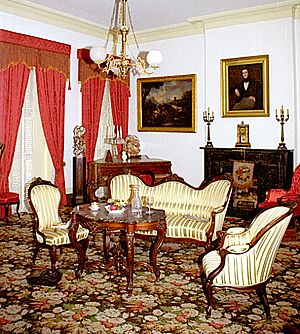1850 House facts for kids

Furniture on display
|
|
| Established | 1850 |
|---|---|
| Location | New Orleans |
| Type | Antebellum row house |
| Architect | James Gallier, Sr. |
The 1850 House is a special museum in New Orleans, Louisiana. It is part of the Louisiana State Museum. This house shows what life was like in the mid-1800s in New Orleans. It is a "row house," meaning it's one of many houses built side-by-side in a row. You can find it at 523 St. Ann Street, right on Jackson Square in the famous French Quarter.
Contents
History of the 1850 House
The 1850 House is located in one of the Pontalba Buildings. These buildings were finished around 1850. They were built by a powerful woman named Micaela Almonester, Baroness de Pontalba. She was the daughter of Don Andres Almonaster y Rojas, who owned a lot of land. He also helped build the Cathedral and Presbytere nearby.
Designing the Pontalba Buildings
The Baroness wanted these buildings to look like grand homes in Paris, France. They were designed to be fancy homes and also have shops on the ground floor. She hired a well-known architect, James Gallier, Sr., to design them. However, she later chose Samuel Stewart to be the builder instead. The Baroness also helped improve Jackson Square and the nearby church buildings.
What the Buildings Were Like
When the Pontalba Buildings were finished, each one had sixteen separate houses upstairs. Downstairs, there were shops. You can see the letters "A" and "P" on the iron railings. These stand for the Almonaster and Pontalba families. In the mid-1800s, the first floor of these buildings had many businesses. These included clothing stores, law offices, and even banks. The upper floors had living spaces with parlors, dining rooms, and bedrooms. There was also a back wing, often used for storage or by household staff.
Who Lived Here?
Records from the 1850s show that many people who rented in the Pontalba Buildings were merchants. They were wealthy enough to live in one of New Orleans's most fashionable areas. An average of nine people lived in each house. This included families, their children, and household staff.
Families at #8 St. Ann Street
- The Soria Family: This family were merchants who moved to New Orleans from New York. They came to find new business chances. Like many residents, the Sorias had several enslaved people working in their home.
- The Cammack Family: Widow Amelia Zacharie Saul Cammack lived here with her son, Thomas, and three daughters. They also had several enslaved people. The way the museum is set up today shows how the Cammacks might have lived from 1853 to 1856.
- William G. Hewes: He moved into the house in 1856 with his two daughters and five enslaved people. Mr. Hewes was important in business. He was the president of a bank and a railroad company.
The 1850 House Museum
The Louisiana State Museum took over the building in 1927. The 1850 House opened to the public as a museum in 1948. The museum shows what a middle-class family's home looked like during New Orleans's most successful time. It is filled with furniture, art, and decorations from that period. You can take a self-guided tour or sometimes join a guided tour.
What You Will See Inside
The 1850 House does not show the home of just one family. Instead, it shows what life was like for many prosperous families in New Orleans in the mid-1800s. Some items in the house were owned by Louisiana families. Other pieces were made or sold by local furniture shops. The house features different popular styles from the 1850s. These include rococo revival, Gothic revival, and classical revival.
Museum Highlights
- Beautiful Old Paris porcelain dishes.
- Silverware made in New Orleans.
- A large six-piece bedroom set. This includes a big bed, a dressing table, two tall wardrobes, a washstand, and a nightstand.
- Other furniture by famous makers like William McCracken and J & JW Meeks.
- Paintings by French artists who came to New Orleans in the early to mid-1800s. These artists include Jacques Amans and Jean Joseph Vaudechamp.
1850 House Museum Store
The Friends of the Cabildo group runs the 1850 House Museum Store. This is the official gift shop for the Louisiana State Museum sites in New Orleans. The store is also located on Jackson Square, in the historic Lower Pontalba Buildings. The money from the store helps support the Louisiana State Museum.
What You Can Find at the Store
At the store, you can find many unique items. These include handmade art, jewelry, pottery, and crafts by local artists. There are also books about Louisiana history, food, and culture. You can buy items related to the museum's exhibits. The store also sells tickets for French Quarter walking tours. These tours include free entry to the 1850 House Museum.

